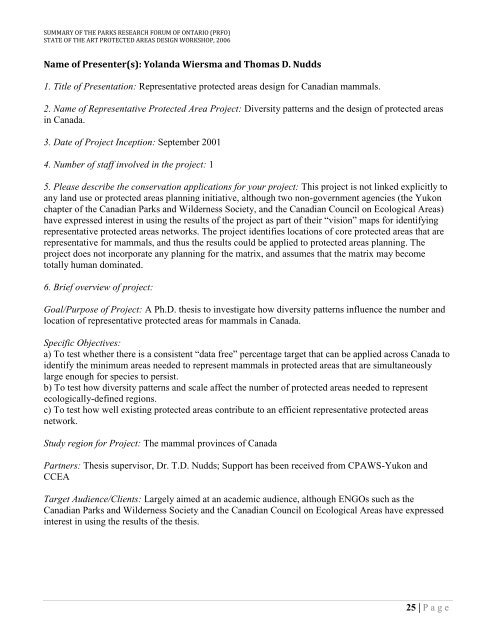Top-Down vs. Bottom Up: Working Towards Consensus ... - CASIOPA
Top-Down vs. Bottom Up: Working Towards Consensus ... - CASIOPA
Top-Down vs. Bottom Up: Working Towards Consensus ... - CASIOPA
- No tags were found...
Create successful ePaper yourself
Turn your PDF publications into a flip-book with our unique Google optimized e-Paper software.
SUMMARY OF THE PARKS RESEARCH FORUM OF ONTARIO (PRFO)STATE OF THE ART PROTECTED AREAS DESIGN WORKSHOP, 2006Name of Presenter(s): Yolanda Wiersma and Thomas D. Nudds1. Title of Presentation: Representative protected areas design for Canadian mammals.2. Name of Representative Protected Area Project: Diversity patterns and the design of protected areasin Canada.3. Date of Project Inception: September 20014. Number of staff involved in the project: 15. Please describe the conservation applications for your project: This project is not linked explicitly toany land use or protected areas planning initiative, although two non-government agencies (the Yukonchapter of the Canadian Parks and Wilderness Society, and the Canadian Council on Ecological Areas)have expressed interest in using the results of the project as part of their “vision” maps for identifyingrepresentative protected areas networks. The project identifies locations of core protected areas that arerepresentative for mammals, and thus the results could be applied to protected areas planning. Theproject does not incorporate any planning for the matrix, and assumes that the matrix may becometotally human dominated.6. Brief overview of project:Goal/Purpose of Project: A Ph.D. thesis to investigate how diversity patterns influence the number andlocation of representative protected areas for mammals in Canada.Specific Objectives:a) To test whether there is a consistent “data free” percentage target that can be applied across Canada toidentify the minimum areas needed to represent mammals in protected areas that are simultaneouslylarge enough for species to persist.b) To test how diversity patterns and scale affect the number of protected areas needed to representecologically-defined regions.c) To test how well existing protected areas contribute to an efficient representative protected areasnetwork.Study region for Project: The mammal provinces of CanadaPartners: Thesis supervisor, Dr. T.D. Nudds; Support has been received from CPAWS-Yukon andCCEATarget Audience/Clients: Largely aimed at an academic audience, although ENGOs such as theCanadian Parks and Wilderness Society and the Canadian Council on Ecological Areas have expressedinterest in using the results of the thesis.25 | P a g e


